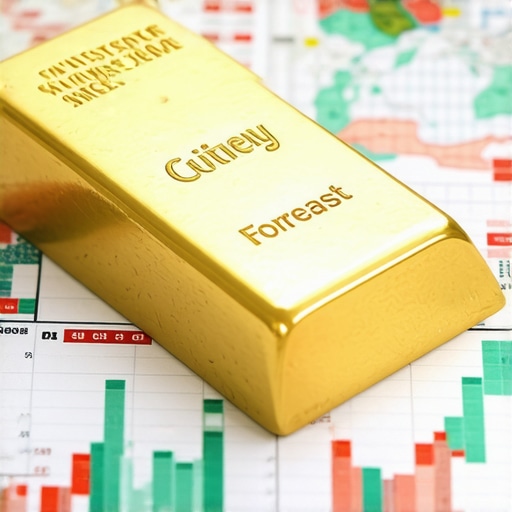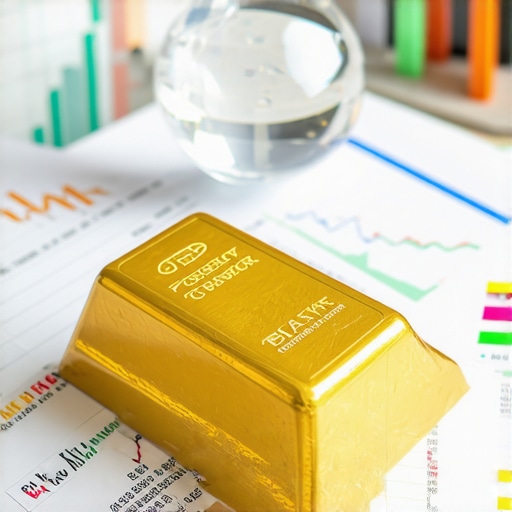Understanding the Relationship Between Economic Trends and Gold Prices
Gold has always been a safe haven for investors, especially during times of economic uncertainty. The relationship between economic trends and gold price movements is a fascinating subject that every investor should understand. The price of gold often reacts to various economic indicators such as inflation rates, interest rates, and the overall economic stability of a country. As investors seek to preserve their wealth, they turn to gold, which traditionally holds its value better than other assets during turbulent times.
How Do Economic Trends Affect Gold Prices?
When economic indicators suggest a downturn, gold prices typically rise. This phenomenon occurs because gold is viewed as a hedge against inflation and currency devaluation. For example, during periods of high inflation, the purchasing power of currency decreases, prompting investors to buy gold as a way to protect their assets. In contrast, when the economy is performing well and inflation is low, gold prices may decline as investors are more likely to invest in stocks and other riskier assets.
The demand for gold can also be influenced by central bank policies. For instance, when central banks lower interest rates, the opportunity cost of holding gold decreases, encouraging more investment in physical gold. Conversely, when interest rates rise, yields on other investments, such as bonds, become more attractive, leading to a potential drop in gold prices. According to a report by the World Gold Council, the correlation between interest rates and gold prices is a key factor for investors to consider when making decisions about gold investments.
What External Factors Play a Role in Gold Price Movements?
Other external factors that can significantly influence gold prices include geopolitical tensions, currency fluctuations, and changes in global demand for gold. For example, during times of political unrest or economic sanctions, investors often flock to gold as a reliable store of value. Additionally, fluctuations in the U.S. dollar can impact gold prices, as gold is usually traded in dollars. When the dollar weakens, gold becomes cheaper for foreign investors, often leading to increased demand and higher prices.
Understanding these dynamics is crucial for anyone looking to invest in gold. Keeping an eye on economic indicators and global events can provide valuable insights into potential price movements. For more information on how to analyze gold supply and demand for investment gains, check out our detailed guide on analyzing gold supply and demand.
Conclusion: Preparing for Future Gold Investments
In conclusion, the interplay between economic trends and gold prices is complex but essential for investors to grasp. By staying informed about the economic landscape and understanding how various factors influence gold prices, you can make more strategic investment decisions. What factors do you think will impact gold prices in the coming year? Share your thoughts in the comments below!
Understanding the Role of Geopolitical Events in Gold Prices
Geopolitical events significantly impact gold prices, often causing spikes in demand. Investors turn to gold as a safe haven during crises, such as wars, political instability, or economic sanctions. For example, recent tensions in Eastern Europe have led to increased gold purchases as investors seek to hedge against uncertainty. According to the Wikipedia article on gold as an investment, historical trends show that gold prices often surge during geopolitical unrest due to heightened demand from risk-averse investors.
What Are the Key Economic Indicators That Affect Gold Prices?
Several economic indicators affect gold prices, including unemployment rates, consumer confidence, and manufacturing output. High unemployment rates often correlate with economic downturns, prompting investors to flock to gold as a stable investment. Similarly, low consumer confidence can indicate economic instability, causing a rise in gold prices as investors seek security. Monitoring these indicators can provide valuable insights into potential gold price movements.
Another crucial factor is the relationship between gold prices and stock market performance. When stock markets are volatile or declining, investors typically pivot towards gold, viewing it as a safer asset. This shift can lead to a significant increase in gold prices, particularly if accompanied by poor economic data.
Analyzing Market Trends for Strategic Gold Investments
To make informed decisions, investors should analyze market trends and economic forecasts. Understanding how economic policies, such as fiscal stimulus or changes in interest rates, affect gold prices is essential. For instance, when governments implement significant fiscal stimulus, it can lead to inflationary pressures, increasing gold’s appeal as a hedge. Furthermore, tracking investor sentiment and market speculation can help predict short-term price movements. For deeper insights, consider reading our guide on gold price predictions.
How Do Global Supply and Demand Dynamics Influence Gold Prices?
Global supply and demand dynamics also play a critical role in gold price fluctuations. A rise in demand for gold jewelry, especially from countries like India and China, can push prices higher. Additionally, changes in mining output or discoveries of new gold reserves can impact the supply side, further influencing prices. Staying updated on these trends is vital for any investor looking to capitalize on the gold market.
In conclusion, the interplay between economic trends and gold prices is complex and multifaceted. By staying informed about global events and economic indicators, investors can make strategic decisions that align with their financial goals. Are you considering investing in gold? Share your thoughts and experiences in the comments below!
Evaluating the Current Trends Influencing Gold Prices
As we delve deeper into the dynamics of gold investment, it’s essential to stay informed about current market trends and geopolitical factors that can shape gold prices. The global economy is in a constant state of flux, and understanding these changes can provide valuable insights for investors looking to navigate the complexities of the gold market. The interplay between various events, such as trade disputes, political instability, and economic reforms, significantly impacts investor sentiment towards gold.
What Role Do Geopolitical Events Play in Gold Price Fluctuations?
Geopolitical events can create significant volatility in gold prices. When tensions rise—whether due to military conflicts, sanctions, or diplomatic disputes—investors often flock to gold as a safe haven. For example, the recent tensions in the Middle East and trade wars between major economies have historically resulted in spikes in gold demand. According to the World Gold Council, periods of uncertainty often lead to increased purchases of gold as investors seek to mitigate risks associated with market instability.
Furthermore, as central banks around the world adjust their monetary policies in response to geopolitical tensions, the demand for gold can shift accordingly. Central banks may increase their gold reserves in times of uncertainty, which can further drive up gold prices. Keeping an eye on these trends is crucial for investors who want to make informed decisions regarding their gold investments.
How Are Economic Policies Influencing Gold Investments?
Economic policies, such as interest rate adjustments and inflation control measures, also have a significant impact on gold prices. When central banks, like the Federal Reserve in the U.S., signal potential interest rate hikes, gold prices may decline as investors shift their focus to interest-bearing assets. Conversely, when rates are lowered or remain stable, gold often becomes more attractive as a non-yielding asset. This dynamic highlights the importance of monitoring economic policy announcements and understanding their implications for gold investments.
Additionally, inflation is a key concern for investors. Rising inflation rates can erode purchasing power, leading individuals to seek refuge in gold as a hedge against inflation. Historical data shows that gold has performed well during inflationary periods, making it a valuable asset for preserving wealth.
What Are the Best Strategies for Investing in Gold?
Investing in gold requires a strategic approach to maximize returns. One effective strategy is to diversify your portfolio by incorporating various forms of gold investments, such as physical gold, ETFs, and gold mining stocks. This diversification can help mitigate risks associated with market volatility and enhance potential gains.
Moreover, staying updated on global supply and demand trends can significantly benefit your investment strategy. The demand for gold jewelry, particularly in emerging markets like India and China, plays a crucial role in price movements. Tracking these trends allows investors to capitalize on market opportunities effectively.
In conclusion, understanding the impact of geopolitical events and economic policies on gold prices is essential for any investor looking to navigate the gold market successfully. By staying informed and employing effective investment strategies, you can position yourself to make the most of your gold investments. What strategies have you found effective in your investment journey? Feel free to share your insights in the comments below!
Understanding the Impact of Economic Policies on Gold Prices
Economic policies play a crucial role in shaping the landscape of gold investments. Changes in monetary policy, fiscal strategies, and regulatory frameworks can create ripples throughout the gold market. For instance, when a central bank decides to alter interest rates, it can significantly affect gold prices. Lower interest rates typically lead to a decline in the opportunity cost of holding gold, thereby increasing its attractiveness to investors.
How Do Interest Rates Influence Gold Investments?
Interest rates are pivotal in determining gold’s appeal as an investment. When rates are low, the yield on interest-bearing assets diminishes, prompting investors to seek alternative investments such as gold. Conversely, rising rates can lead to a decrease in gold demand as other investments become more lucrative. According to the World Gold Council, historical data indicates that gold prices often rise when interest rates fall, as investors look to hedge against potential economic downturns.
Additionally, inflation expectations can drive gold prices higher. Investors often view gold as a hedge against inflation, and when inflation rates are projected to rise, demand for gold typically increases. This dynamic underlines the importance of monitoring economic indicators such as Consumer Price Index (CPI) and Producer Price Index (PPI) to anticipate potential movements in gold prices.
What Other Economic Indicators Affect Gold Prices?
Several economic indicators can influence gold prices beyond interest rates and inflation. For example, unemployment rates provide significant insights into the economic health of a nation. High unemployment often correlates with economic instability, prompting investors to shift their focus to gold as a more secure asset. Similarly, shifts in manufacturing output and consumer confidence can impact investor sentiment and, ultimately, gold prices.
Moreover, global economic conditions can affect demand for gold. Economic growth in major markets like China and India can lead to increased demand for gold jewelry and investment, pushing prices higher. Thus, staying informed about international economic trends is crucial for investors.
Strategies for Navigating Gold Investments
Given the various factors influencing gold prices, it is essential to develop a strategic approach to investing in gold. Diversifying your portfolio by incorporating different forms of gold investments—such as physical gold, ETFs, and mining stocks—can help mitigate risks and enhance potential returns. Investors should also stay updated on macroeconomic trends and geopolitical developments, as these can significantly impact gold prices.
Additionally, consider setting up alerts for economic reports and news that may affect gold investments. By being proactive and informed, you can make timely decisions that align with market movements.
What Are Your Gold Investment Goals?
As you navigate the complexities of the gold market, it’s essential to define your investment goals. Are you looking to hedge against inflation, diversify your portfolio, or speculate on price movements? Understanding your objectives will help you tailor your investment strategy effectively.
In conclusion, economic policies and indicators play a vital role in shaping gold prices. By staying informed and employing sound investment strategies, you can position yourself to make the most of your gold investments. For further insights into gold investment strategies and market trends, explore our comprehensive guides on gold investment strategies and evaluating gold demand trends. What strategies do you find effective for investing in gold? Share your experiences in the comments below!
Frequently Asked Questions (FAQ)
What factors influence gold prices the most?
Gold prices are primarily influenced by economic indicators such as inflation rates, interest rates, and currency fluctuations. Additionally, geopolitical events and central bank policies play significant roles in shaping gold price movements.
How can I invest in gold as a beginner?
Beginners can start investing in gold by purchasing physical gold such as coins or bars, or by investing in gold ETFs and mutual funds. It’s essential to research and choose the investment method that aligns with your financial goals and risk tolerance.
What is the best time to buy gold?
The best time to buy gold is often when prices are low and market sentiment is bearish. Monitoring economic indicators and global events can help identify favorable buying opportunities. Additionally, buying during seasonal demand spikes, such as festivals in India, can also be advantageous.
How does inflation affect gold investments?
Inflation erodes the purchasing power of currency, prompting investors to seek refuge in gold, which historically retains its value. As inflation rises, demand for gold typically increases, driving prices higher.
What are the risks associated with investing in gold?
Investing in gold carries risks such as price volatility, lack of income generation (as gold does not yield dividends), and potential storage costs for physical gold. Understanding these risks is crucial for making informed investment decisions.
Can gold be part of a retirement portfolio?
Yes, gold can be included in a retirement portfolio as a hedge against inflation and market volatility. Investors can hold gold in various forms, including ETFs, mutual funds, or physical gold within an IRA, depending on their retirement strategy.
How do global demand trends impact gold prices?
Global demand trends, particularly from major markets like India and China, significantly impact gold prices. Increased demand for gold jewelry and investment from these countries can lead to price surges, while a decline in demand can have the opposite effect.
What role do central banks play in the gold market?
Central banks influence the gold market by adjusting their gold reserves and monetary policies. When central banks increase their gold holdings, it typically boosts demand and prices. Their policies regarding interest rates also affect gold’s attractiveness as an investment.
Is it better to invest in physical gold or gold stocks?
The choice between physical gold and gold stocks depends on individual investment goals. Physical gold offers a tangible asset for security, while gold stocks can provide potential for higher returns through company performance but come with higher risks. Diversifying between both options can be a prudent strategy.
How can I stay informed about gold market trends?
Staying informed about gold market trends involves regularly monitoring economic news, subscribing to financial publications, and following reputable financial analysts or gold market experts. Resources such as the World Gold Council and financial news websites can provide valuable insights.
Authoritative Sources
The following sources were referenced in this article to provide accurate information and insights on gold investments:
World Gold Council – A leading authority on gold and its role in investment, providing comprehensive data and research on gold trends.
Investopedia – A trusted resource for financial education, offering in-depth articles on gold investments and market analysis.
Forbes – A reputable business publication that covers trends in investing, including the gold market and economic factors influencing prices.
Bloomberg – A global leader in business and financial news, providing insights into gold price movements and economic analysis.
Conclusion
In summary, understanding the dynamics of gold prices and the various economic factors that influence them is crucial for making informed investment decisions. By staying informed about market trends, geopolitical events, and economic indicators, investors can strategically position themselves in the gold market. Embracing a diversified investment approach, particularly in times of uncertainty, can enhance your portfolio’s resilience. If you found this information valuable, please share your thoughts in the comments below or explore our related articles for further insights on gold investments!










This post really sheds light on the multifaceted nature of gold price movements influenced by economic trends. One thing that stood out to me is the delicate balance investors must consider with interest rates. In my experience, the challenge lies in timing investments around central bank policies—often, rate changes aren’t immediately reflected in gold prices, leading to short-term market confusion. I’ve noticed that geopolitical events, particularly unexpected ones like sudden trade disputes or regional conflicts, tend to accelerate gold buying regardless of current economic indicators. It seems that gold’s role as a safe haven isn’t just about inflation or economic downturns but also a psychological hedge against uncertainty. I’m curious about how others approach this balancing act—do you prioritize immediate economic indicators or pay closer attention to geopolitical tensions when deciding to invest in gold? Also, with the rise of digital assets, do you think the traditional relationship between economic trends and gold prices might change in the coming years? Looking forward to hearing different perspectives on navigating these complexities.